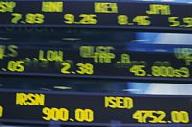
 |
|
| Financial Terms | |
| Order penetration point |
|
Information about financial, finance, business, accounting, payroll, inventory, investment, money, inventory control, stock trading, financial advisor, tax advisor, credit.
Main Page: payroll, inventory control, accounting, inventory, financial, financial advisor, finance, investment, |
Definition of Order penetration point
Order penetration pointThe point in the production process when a product is
Related Terms:Basis pointIn the bond market, the smallest measure used for quoting yields is a basis point. Each percentage Bond pointsA conventional unit of measure for bond prices set at $10 and equivalent to 1% of the $100 face Buy limit orderA conditional trading order that indicates a security may be purchased only at the designated Cash-flow break-even pointThe point below which the firm will need either to obtain additional financing Cross-border riskRefers to the volatility of returns on international investments caused by events associated Day orderAn order to buy or sell stock that automatically expires if it can't be executed on the day it is entered. Delivery pointsThose points designated by futures exchanges at which the financial instrument or  Economic order quantity (EOQ)The order quantity that minimizes total inventory costs. Fill or kill orderA trading order that is canceled unless executed within a designated time period. Limit orderAn order to buy a stock at or below a specified price or to sell a stock at or above a specified Limit order bookA record of unexecuted limit orders that is maintained by the specialist. These orders are Market orderThis is an order to immediately buy or sell a security at the current trading price. Negotiable order of withdrawal (NOW)Demand deposits that pay interest. Open (good-til-cancelled) orderAn individual investor can place an order to buy or sell a security. That Pecking-order view (of capital structure)The argument that external financing transaction costs, especially PointThe smallest unit of price change quoted or, one one-hundredth of a percent. Related: minimum price Point and figure chartA price-only chart that takes into account only whole integer changes in price, i.e., a Price value of a basis point (PVBP)Also called the dollar value of a basis point, a measure of the change in Sell limit orderConditional trading order that indicates that a, security may be sold at the designated price or Stop-loss orderAn order to sell a stock when the price falls to a specified level. Stop order (or stop)An order to buy or sell at the market when a definite price is reached, either above (on a Stop-limit orderA stop order that designates a price limit. In contrast to the stop order, which becomes a Breakeven pointThe point at which total costs equal total revenue, i.e. where there is neither a profit nor a loss. breakeven pointThe annual sales volume level at which total contribution Basis PointOne one-hundredth of one percent break-even point (BEP)the level of activity, in units or dollars, at which total revenues equal total costs economic order quantity (EOQ)an estimate of the number engineering change order (ECO)a business mandate that changes the way in which a product is manufactured or a job order cost sheeta source document that provides virtually job order costing systema system of product costing used open purchase orderinga process by which a single purchase ordering costthe variable cost associated with preparing, order pointthe level of inventory that triggers the placement special order decisiona situation in which management must determine a sales price to charge for manufacturing or service jobs outside the company’s normal production/service market split-off pointthe point at which the outputs of a joint process are first identifiable or can be separated as individual products Basis pointOne hundredth of one percentage point, or 0.0001. Point and figure chartA financial chart usually used to plot asset price data. Breakeven pointThe sales level at which a company, division, or product line makes a Split-off pointThe point in a production process when clearly identifiable joint costs economic order quantityorder size that minimizes total inventory costs. pecking order theoryFirms prefer to issue debt rather than equity if internal finance is insufficient. Basis PointOne one-hundredth of a percentage point, used to express variations in yields. For example, the difference between 5.36 percent and 5.38 percent is 2 basis points. Turning PointThe trough or peak of a business cycle. Free-on-Board (FOB) Shipping PointA shipping arrangement agreed to between buyer and Discrete order pickingA picking method requiring the sequential completion of Make-to-orderA production scheduling system under which products are only Order pickingThe process of moving items from stock for shipment to customers. Outbound stock pointA designated inventory location on the shop floor between Point-of-use deliveryA delivery of stock to a location in or near the shop floor Point-of-use storageThe storage of stock in a location in or near the shop floor StockpointAn inventory storage area used for short-term inventory staging. money orderA guaranteed form of payment in amounts up to and including $5,000. You might request a money order in order to pay for tuition fees at a university or a college, or for a magazine subscription. point of sale (POS)The terminal at which a customer uses his/her debit card to make a direct payment transaction. See also Interac Direct Payment. Related to : financial, finance, business, accounting, payroll, inventory, investment, money, inventory control, stock trading, financial advisor, tax advisor, credit. |